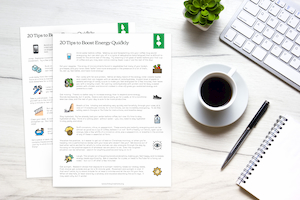Extra Virgin Olive Oil (EVOO) was all the health rage for several years, but now it seems that dozens of types of oils are popping up on Instagram and in recipes. Are you overwhelmed by all of the types of oils? Just want to know what the healthiest type of oil is? Learn about smoke points, read through the benefits and drawbacks of each oil, and then discover my recommendation for the two best types of oils to keep on hand!
What is a smoke point?
To understand why different oils are healthier for different reasons, you need to understand what a smoke point is. Simply, it’s the temperature at which an oil begins to smoke as it is heated. But doing so has health complications – when an oil is heated past its smoke point, many of the healthy nutrients are destroyed (so you’re still getting the calories, without any nutritional benefit). The oil can also oxidize, creating harmful free radicals, which are tied to long-term health complications and chronic diseases over time.
So, we only want to use an oil at a temperature under its smoke point. If you’re consuming an oil at room temperature (or chilled), any oil is just fine. But if you’re cooking, you’ll want to use an oil that has a smoke point under the temperature at which you’re cooking. Usually, for stove-top pan-frying, this is around 300 degrees Fahrenheit, and for ovens, this is around 400 degrees Fahrenheit (depending on the temperature at which you set your stove).
What are the benefits of each oil type?
| Oil Type | Smoke Point (in °F) | Benefits | Drawbacks |
|---|---|---|---|
| Avocado Oil | 570 |
|
|
| Extra Virgin Olive Oil | 320-370 |
|
|
| “Regular” or “Extra Light” Olive Oil | 390-470 |
|
|
| Coconut Oil | Virgin: 350 Refined: 400 |
|
|
| Ghee | 485 |
|
|
| Vegetable Oil | 320-450 |
|
|
| Canola Oil (also called rapeseed oil) | 400 |
|
|
| Grapeseed Oil | 392 |
|
|
| Sunflower or Safflower Oil | Unrefined: 320 Refined: 450 |
|
|
Which is the healthiest type of oil?
Overall, I recommend keeping one oil (I suggest extra virgin olive oil) on hand for drizzling on salads, making dressings, and using in any other raw or low-heat preparation. I also recommend keeping another oil (I suggest avocado oil or ghee) for high heat cooking, stir-frying, and baking. If you do a lot of roasting, I also suggest a high-heat, preservative- and chemical-free cooking spray (I like this avocado oil spray). With those 2-3 options on hand, you’re covered!
By the way, you may have noticed that most of my product recommendations link to brands that come in darker-colored bottles. This helps prevent the oil from oxidizing when exposed to sunlight in your kitchen or heat from your oven. I do suggest keeping your oil in the pantry or a cabinet that is not right above the stove, to keep it away from as much light and heat as possible!
Now it’s your turn … Which oil is your favorite to keep on hand? How many types of oils do you have in your pantry?




This is exactly what I was looking for – a clear, concise comparison of the pros/cons of different cooking oils! Thank you. I had been researching and reading a lot on this topic recently, and it can be very confusing with conflicting information out there.
I’m so glad it helped, Diane! Always trying to make nutrition more understandable!
My whole life I’ve used extra-virgin olive oil for everything except a few baking recipes for which I use canola oil. But thanks to Megan I have replaced almost all canola oil with coconut oil. I love popcorn popped in coconut oil! Usually Once I’ve cooked a stirfry, I drizzle sesame seed oil over it for flavor. I’m excited to try avocado oil.
Thanks so much for sharing, and congratulations on your shift, Victoria!